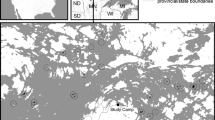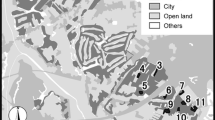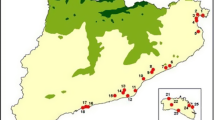Summary
We found several rare UK butterflies to be restricted to relatively large and non-isolated habitat patches, while small patches and those that are isolated from population sources remain vacant. These patterns of occurrence are generated by the dynamic processes of local extinction and colonization. Habitat patches act as terrestrial archipelagos in which long-term population persistence, and hence effective long-term conservation, rely on networks of suitable habitats, sufficiently close to allow natural dispersal.
Similar content being viewed by others
References
Boorman SA, Levitt PR (1973) Group selection on the boundary of a stable population. Theor Popul Biol 4: 85–128
Diamond JM (1975) Assembly of species communities. In: Cody ML, Diamond JM (eds) Ecology and Evolution of Communities. Harvard Univ Press, Cambridge, Mass, pp 342–444
Gilpin ME (1980) The role of stepping-stone islands. Theor Popul Biol 17: 247–253
Gilpin M, Hanski I (eds) (1991) Metapopulation dynamics: empirical and theoretical investigations. Academic Press, London
Harrison S (1989) Long-distance dispersal and colonization in the bay checkerspot butterfly. Ecology 70: 1236–1243
Harrison S, Murphy DD, Ehrlich PR (1988) Distribution of the bay checkerspot butterfly, Euphydryas editha bayensis: evidence for a metapopulation model. Am Nat 132: 360–382
Hensher DA, Johnson LW (1981) Applied Discrete-Choice Modelling. Croom Helm, London
Holdren CE, Ehrlich PR (1981) Long range dispersal in checkerspot butterflies: transplant experiments with Euphydryas gillettii. Oecologia 50: 125–129
Lande R (1988) Genetics and demography in biological conservation. Science 241: 1455–1460
Lawton JH, Woodroffe GL (1991) Habitat and the distribution of water voles: why are there gaps in a species' range? J Anim Ecol 60: 79–91
Lovejoy TE, Bierregaard RO, Rylands AB, Malcolm JR, Quintela CE, Harper LH, Brown KS, Powell AH, Powell GVN, Schubar HOR, Hays MB (1986) In: Soulé ME (ed) Conservation Biology. The Science of Scarcity and Diversity. Sinauer Ass, Sunderland, Mass, pp 257–285
MacArthur RH, Wilson EO (1967) The theory of island biogeography. Princeton Univ Press, Princeton
Oates MR, Warren MS (1990) A Review of Butterfly Introductions in Britain and Ireland. JCCBI/WWF, Godalming
Schoener TW (1991) Extinction and the nature of the metapopulation: a case system. Acta Oecol 12: 53–75
Simberloff DS (1976) Species turnover and equilibrium island biogeography. Science 194: 572–578
Simberloff D (1988) The contribution of population and community biology to conservation science. Annu Rev Ecol Syst 19: 473–511
Sjogren P (1991) Extinction and isolation gradients in metapopulations: the case of the pool frog (Rana lessonae) Biol J Linn Soc 42: 135–147
Soulé ME, Bolger DT, Alberts AC, Wright J, Sorice M, Hill S (1988) Reconstructed dynamics of rapid extinctions in chaparralrequiring birds in urban habitat islands. Conserv Biol 2: 75–92
Taylor B (1991) Investigating species incidence over habitat fragments of different areas — a look at error estimation. Biol J Linn Soc 42: 177–191
Thomas CD (1985a) Specializations and polyphagy of Plebejus argus (Lepidoptera: Lycaenidae) in North Wales. Ecol Entomol 10: 325–340
Thomas CD (1985b) The status and conservation of the butterfly Plebejus argus (Lepidoptera: Lycaenidae) in North West Britain. Biol Conserv 33: 29–51
Thomas CD, Harrison S (1992) Spatial dynamics of a patchily distributed butterfly species. J Anim Ecol 61: 437–446
Thomas CD, Jones TM (1992) Partial recovery of a skipper butterfly (Hesperia comma) from population refuges: lessons for conservation in a fragmented landscape. J Anim Ecol (in press)
Thomas JA (1974) Ecological Studies of Hairstreak Butterflies. PhD thesis, Univ Leicester
Thomas JA (1983a) A quick method of assessing butterfly numbers during surveys. Biol Conserv 27: 195–211
Thomas JA (1983b) The ecology and status of Thymelicus acteon (Lepidoptera: Hesperiidae) in Britain. Ecol Entomol 8: 427–435
Thomas JA (1991) Rare species conservation: case studies of European butterflies. In: Spellerberg IF, Goldsmith FB, Morris MG (eds) The Scientific Management of Temperate Communities for Conservation. Br Ecol Soc Symp 31: 149–197
Thomas JA, Thomas CD, Simcox DJ, Clarke RT (1986) The ecology and declining status of the silver-spotted skipper butterfly (Hesperia comma) in Britain. J Appl Ecol 23: 365–380
Trout RC, Tittensor AM (1989) Can predators regulate wild rabbit Oryctolagus cuniculus population density in England and Wales? Mammal Rev 19: 153–173
Trout RC, Tapper FC, Harradine J (1986) Recent trends in the rabbit population in Britain. Mammal Rev 16: 117–123
Warren MS (1987a) The ecology and conservation of the heath fritillary butterfly Mellicta athalia, I. Host selection and phenology. J Appl Ecol 24: 467–482
Warren MS (1987b) The ecology and conservation of the heath fritillary butterfly Mellicta athalia, II. Adult population structure and mobility. J Appl Ecol 24: 483–498
Warren MS (1987c) The ecology and conservation of the heath fritillary butterfly Mellicta athalia, III. Population dynamics and the effect of management. J Appl Ecol 24: 499–513
Warren MS (1991) The successful conservation of an endangered species, the heath fritillary butterfly Mellicta athalia, in Britain. Biol Conserv 55: 37–56
Warren MS (in press) A review of butterfly conservation in central southern Britain I. Protection, evolution and extinction on prime sites. Biol Conserv
Warren MS, Thomas CD, Thomas JA (1984) The status of the heath fritillary butterfly Mellicta athalia Rott. in Britain. Biol Conserv 29: 287–305
Wilcove DS, McLellan CH, Dobson AP (1986) Habitat fragmentation in the temperate zone. In: Soulé ME (ed) Conservation Biology. The Science of Scarcity and Diversity. Sinauer Ass, Sunderland, Mass, pp 237–256
Williamson M (1981) Island Populations. Oxford University Press, Oxford
Author information
Authors and Affiliations
Additional information
Present address: School of Biological Sciences, The University of Birmingham, Edgbaston, Birmingham, B15 2TT, UK
Rights and permissions
About this article
Cite this article
Thomas, C.D., Thomas, J.A. & Warren, M.S. Distributions of occupied and vacant butterfly habitats in fragmented landscapes. Oecologia 92, 563–567 (1992). https://doi.org/10.1007/BF00317850
Received:
Accepted:
Issue Date:
DOI: https://doi.org/10.1007/BF00317850




